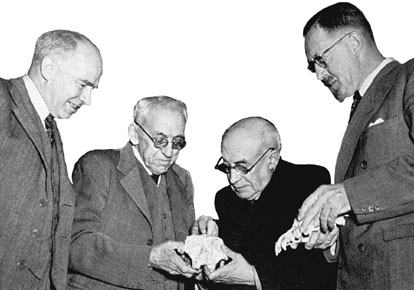

 | Page 407 |  |
of the Study of Man in Africa was founded at the University of Witwatersrand in his honor.

“Peter” van Riet Lowe (right) with (from left to right) Raymond Dart, Robert Broom, and abbé breuil examining an “ape-man” skull
(H. J. Deacon)
Dart is best known for the discovery and interpretation of the fossilized child’s skull found in a limestone deposit at the Buxton Limeworks near Taung in northern Cape Province, South Africa, in November 1924. In an article in Nature in February 1925, Dart argued that the Taung skull was evidence for the presence of an anthropoid ape in Africa that, based on elements of its morphology, had become more human. He called it Australopithecus africanus, and while it did not fit into the ape family, Dart could not (at first) classify it as a member of the family Hominidae either, because of its small brain size.
For the next twenty-five years the place of Australopithecus and its significance was disputed and Dart’s expertise attacked. Dart argued that the size of the Taung brain was not as important as its form, and that other early humans had shown that the principle of mosaic evolution was possible. This meant that some parts of the body hominized before others, and not just the brain (as argued by Elliot Smith and Sir Arthur Keith with the piltdown evidence). In the case of the Taung skull, dental and postural hominization were evident even if an increase or hominization of the brain was not. By the 1950s Dart had been vindicated by more Australopithecus discoveries in South Africa, by Robert Broom at Sterkfontein, and in Kenya, by louis leakey. During the same period Piltdown was proven to be a fraud, and Australopithecus was finally classified as an ancestral hominid.
Dart also proposed that before the Stone Age there had been a Bone Age or “osteodontokeratic culture”—when Australopithecus had used the bones, teeth, and horns of their animal prey as tools and implements. Dart based this argument on his extensive study of thousands of fossilized and broken bones from the Australopithecus-bearing cave of Makapansgat in the northern Transvaal. The new discipline of taphonomy was effectively born out of attempts to disprove this last of Dart’s hypotheses.
 |  |